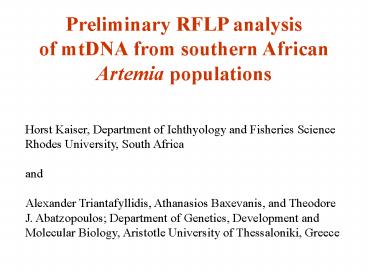Preliminary RFLP analysis - PowerPoint PPT Presentation
Title:
Preliminary RFLP analysis
Description:
Title: PowerPoint Presentation Author: horst kaiser Last modified by: horst kaiser Created Date: 8/24/2002 9:59:35 AM Document presentation format – PowerPoint PPT presentation
Number of Views:311
Avg rating:3.0/5.0
Title: Preliminary RFLP analysis
1
Preliminary RFLP analysis of mtDNA from southern
African Artemia populations
Horst Kaiser, Department of Ichthyology and
Fisheries Science Rhodes University, South Africa
and Alexander Triantafyllidis, Athanasios
Baxevanis, and Theodore J. Abatzopoulos
Department of Genetics, Development and Molecular
Biology, Aristotle University of Thessaloniki,
Greece
2
Artemia life histories
- Bisexual
- Several species with a wide distribution range
- Parthenogenetic
- Different ploidy levels
- Genetics is poorly described
- Mixed populations
3
Potentially interesting southern African Artemia
populations
Namibia Smallest recorded cysts
Madagascar
Coega Undescribed
4
The current projectThessaloniki, Greece
- Main topic Artemia biodiversity
- Sub-topic Genetic structure of southern African
populations - Technique development for Artemia
5
Project objectives
- To develop a data base of genetic markers for
comparison with other populations. - To find genetic markers for African Artemia
populations. - Getting accustomed to molecular techniques
6
Problems with morphometrics as a tool to
differentiate species
- Different species may be very similar
morphometrically. - Results are sensitive to rearing conditions.
- Requires strict standardisation.
7
Molecular techniques
- Using the16s sub-unit of the mitochondrial rDNA
- Maternal inheritance
- Small size (540 base pairs)
- Stable gene arrangement
- Fairly well conserved
8
Individuals from five populations were used for
genetic analysis
- Three parthenogenetic populations from Greece
- Namibia (Swartkopmund)
- Madagascar (near Toliara)
- South Africa (Coega Cerebos salt works)
9
RFLP
- Restriction Fragment Length Polymorphism
- The molecular geneticists version of a
- jigsaw puzzle - without knowing the
- number of pieces.
10
The RFLP recipe
- Use only the best Artemia gently squashed and
homogenised. - For best results use one shrimp at time.
- Prepare with a liberal dose of proteinase (keep
in the oven overnight). - Wash in phenol and chloroform, then spin.
- Add a few picograms of primers and a touch of Taq
enzyme.
continued
11
The RFLP recipe
- Cook while varying the temperature (PCR)
- Add assorted enzymes to cut the PCR product into
smaller units. - Add the rDNA pieces to a bed of gel.
- Let run on gel until well separated.
- Serve results in a table.
12
PCR product from 17 different individuals 1.5
Agarose gel, ethidium bromide stain, 540 base
pairs (bp)
Individuals
Reference ladder 100 bp
13
Restriction of PCR product using the DpnII enzyme
100 bp Ladder
240 bp
180 bp
120 bp
14
Restriction of PCR product using the TaqI enzyme
Artemia parthenogenetica (Greek population)
Artemia parthenogenetica (Greek population)
15
Restriction of PCR product using the HaeIII enzyme
Six individuals from the Coega population(s)
show different restriction patterns An
indication of a mixed population?
16
Examples of different restriction patterns for
two enzymes
17
Haplotypes of different populations
Greek (1) P DBAAABABC 7
Greek (2) P CCCAABABD 7
Greek (2) P CBCAABABD 2
Greek (3) P DBAAABABE 9
Namibia (P) DBAAABABC 8
Madagascar (P) DBAAABABC 10
Coega CBCAAAABD 7
Coega AAAACAABC 1
Coega ABAACAABC 9
A. franciscana AAAAAAAAA -
P A. parthenogenetica numbers are frequencies.
18
Artemia franciscana
Bisexual component from Coega
A. parthenogenetica (Greece)
A. parthenogenetica (Madagascar)
A. parthenogenetica (Greece)
A. parthenogenetica (Namibia)
A. parthenogentica (Greece)
Parthenogenetic component from Coega
Phylogram based on restriction site patterns
19
Interesting preliminary results
- There is a considerable genetic distance between
the two populations from the Coega salt works
(South Africa) - Populations with different life histories appear
to co-exist.
20
Questions and tasks for next year
- Do the environmental requirements differ between
the populations? - Which species represents the bisexual component?
- Survey and study bird migration routes.































